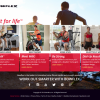Do you know the frame size for your eyeglasses? Many people don’t. While most people get their prescriptions filled according to the right specifications, they don’t know how to look for eyeglass frames that fit, and so purchase them solely on the basis of how they look.
If you want frames that fit over the bridge of your nose and around your ears without pinching or falling off, then it’s important to know your frame size.
Frame size is relatively easy to find on most prescription glasses. (Keep in mind that sunglasses tend to be bigger than eyeglasses, so you might have two different frame sizes.) Typically, the numbers you need are marked on the temple or the bridge of the glasses.

There are three components to frame size: bridge size, temple size, and eye size. The eye size is typically a two-digit number between 40-62. Temple size is a three-digit number in the 120-150 range, and bridge size is a two-digit number in the 14-24 range. They will usually appear next to one another.
The bridge size is most important to know, because it bears the weight of the frames on the face. It should feel comfortable and supportive and maintain the position of the lenses over your eyes when you are looking straight ahead: this is your natural gaze.
The bridge width is the distance between the nasal surfaces of the rims on the frames. Adjustable nose pads are good for comfort and precise fit, too. Depending on how your frames are resting on your face, you might want to increase or decrease the distance between the pads.
If the frame is sitting too high on your face, the bridge is too small fitting for the nose, or the distance from the eye to the lens is too great, then you may want to increase the distance between the pads. However, if the frame sits low on the face, the bridge is too low for the nose, or the lenses are sitting to close to your lashes, you might want to shorten the distance between the pads. Here is a video by Frames Direct which describes how to find your current eyeglasses frame size.
When you are deciding between frame types, you should also consider the shape of your face. Is it oval, round, triangular? This will play a role in finding the right frame for you. For instance, if you have an oval face, most frames will suit – but be sure to choose the right size. For round faces, counterbalancing with rectangular frames is best, and for square faces, oval or round frames are great.
Whatever type of frames you choose, be sure to consider the fit before fashion, so you can be comfortable and preserve your vision, too.












